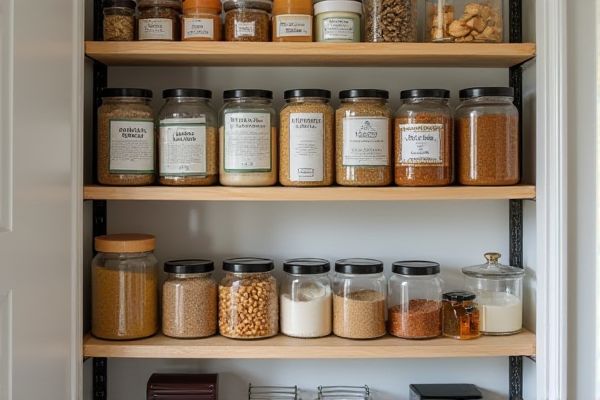
Wire racks offer superior ventilation and resist moisture buildup, making them ideal for storing canned goods and produce, while wood shelves provide a sturdy, aesthetic appeal and support heavier items like appliances and large jars. Explore the rest of this article to determine which pantry storage option best suits your needs.
Table of Comparison
| Feature | Wire Rack | Wood Shelf Pantry |
|---|---|---|
| Material | Metal (usually steel, chrome-coated) | Solid wood (oak, pine, or MDF) |
| Durability | Highly durable, rust-resistant with coating | Durable but susceptible to moisture and warping |
| Weight Capacity | High load capacity, supports heavy items | Moderate load capacity, varies by wood type |
| Ventilation | Excellent airflow to prevent moisture buildup | Limited airflow, can trap moisture |
| Maintenance | Easy to clean with wipes or water | Requires polishing or sealing to maintain appearance |
| Aesthetic | Industrial, functional look | Warm, natural, customizable finish |
| Cost | Generally affordable | Typically more expensive due to material |
| Assembly | Often requires simple assembly | May require professional installation |
Introduction: Comparing Wire Racks and Wood Shelves in Pantries
Wire racks in pantries provide superior ventilation and easy visibility, making them ideal for storing produce and preventing moisture buildup. Wood shelves offer a classic aesthetic with sturdy support, perfect for heavier items and creating a warm, organized look. Choosing between wire racks and wood shelves depends on storage needs, ventilation preferences, and style considerations.
Design and Aesthetic Appeal
Wire racks offer a sleek, industrial design with a minimalist aesthetic that suits modern and utilitarian pantry setups, providing visibility and airflow. Wooden shelves deliver a warm, natural look with customizable finishes that enhance rustic or traditional kitchen decor. The choice between wire racks and wood shelves significantly impacts pantry style, with wire promoting open, airy spaces and wood adding coziness and visual richness.
Durability and Longevity
Wire racks offer superior durability due to their resistance to moisture, rust-resistant coatings, and sturdy metal construction, ensuring long-term use in humid pantry environments. Wood shelves, while aesthetically pleasing, may be prone to warping, cracking, and mold growth over time, particularly in areas with fluctuating humidity and temperature. Overall, wire racks provide increased longevity and require less maintenance compared to wood shelves in pantry storage.
Weight Capacity and Strength
Wire racks offer superior weight capacity and strength compared to wood shelves, making them ideal for storing heavy kitchen items or large quantities of food. Their metal construction provides durability and resistance to bending under load, supporting weights often exceeding 200 pounds per shelf. Your choice between wire racks and wood shelves will impact the organization and safety of your pantry, especially if you store bulky or heavy goods.
Ventilation and Airflow Benefits
Wire racks provide superior ventilation and airflow compared to wood shelves, reducing moisture buildup and preventing mold growth in pantry storage. The open design of wire racks allows air to circulate freely around stored items, which helps maintain freshness and extends the shelf life of food products. Wood shelves, while sturdy, tend to restrict airflow, creating pockets of stagnant air that can lead to increased humidity and potential spoilage.
Maintenance and Cleaning Requirements
Wire racks require minimal maintenance due to their non-porous metal surfaces that resist stains and can be easily wiped down with a damp cloth or mild detergent. Wood shelves demand more thorough cleaning and occasional refinishing to prevent damage from spills, moisture, and pests, as wood is prone to absorbing liquids and harboring bacteria. Choosing wire racks reduces cleaning time and the risk of mold or mildew, making them ideal for busy pantry environments.
Customization and Adjustability
Wire racks offer high customization and adjustability with movable shelves and expandable options ideal for evolving pantry needs. Wood shelves provide sturdy, fixed designs that can be customized during installation but lack the flexibility for frequent adjustments. Your choice depends on whether you prioritize adaptable storage solutions or classic, durable aesthetics in your pantry setup.
Cost Considerations and Budgeting
Wire racks generally offer a more budget-friendly option for pantry storage, with prices ranging from $20 to $100 depending on size and quality. Wood shelves tend to be more expensive, often costing between $100 and $500 or more, especially if crafted from solid hardwood or custom-built. When budgeting, factor in installation costs and durability; wire racks may require less maintenance, while wood shelves add a more aesthetic and sturdy solution that can increase overall pantry value.
Installation Process and Ease
Wire racks offer straightforward installation with minimal tools, often featuring adjustable shelves and pre-drilled holes that simplify setup. Wood shelves may require precise measurements, professional skills, or hardware for mounting, making the process more time-consuming and complex. Your choice depends on whether you prioritize quick installation or a customized, sturdy pantry solution.
Best Use Cases: Which is Right for Your Pantry?
Wire racks are ideal for pantries requiring excellent ventilation and moisture control, making them perfect for storing canned goods, fruits, and vegetables. Wood shelves offer durability and a classic aesthetic, best suited for heavier items and organized pantry arrangements. Selecting between wire racks and wood shelves depends on your storage needs, humidity levels, and desired pantry style.
 homyna.com
homyna.com